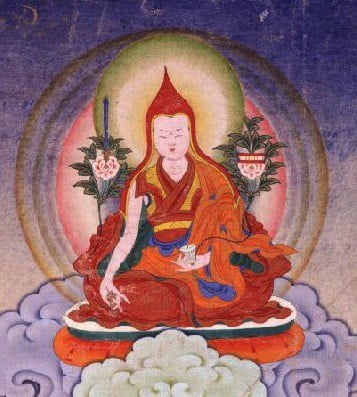Jamyang Khyentsé Wangpo (1820-1892), also known by the name Pema Ösal Do-ngak Lingpa (Tib. པདྨ་འོད་གསལ་མདོ་སྔགས་གླིང་པ), was a contemporary of Chokgyur Lingpa (1829-1870) and Jamgön Kongtrul the Great. The three masters worked together to reveal and validate treasures and each considered the other two as their own masters. This unique cooperative partnership resulted in the flourishing of Dharma and the Rimé (ecumenical) movement in late 19th century Tibet. Jamyang Khyentsé Wangpo was said to be the combined reincarnation of the 8th-century monk translator Vimalamitra as well as King Trisong Deutsen.
Jamyang Khyentse was born in 1820 in the region of Yaru Khyungchen Drak in Dilgo in Derge, East Tibet. His father was Rinchen Namgyal and his mother Sönam Tso. Jamyang Khyentse learnt to read at the age of four or five, and from an early age his intelligence grew so keen he was able to master reading, writing, and other skills without any difficulty. At twelve, he was recognized as the incarnation of the great khenpo of Evam Tharpatse, Jampa Namkha Chime, and he was given the name Jamyang Khyentse Wangpo. At age twenty-one, he received full ordination. In all, he had more than one hundred and fifty teachers, who were great masters from all four major schools—Sakya, Gelug, Kagyü and Nyingma. He studied with masters from every authentic tradition of practice with an unbroken lineage which existed at that time in the Land of Snows. He received these teachings in their entirety and in the proper way, imbibing all the ripening empowerments, liberating instructions, and supporting reading transmissions. Not only did he come to possess infinite learning, he also developed unsurpassable qualities of experience and realization through perfecting the practice of meditation. In time, his fame spread throughout Tibet and the name of Pema Ösal Dongak Lingpa, “holder of the seven special transmissions (ka bab dün),” was heard everywhere like claps of thunder resounding through the land. All that he himself had received of the sutras, tantras, and pith instructions, he passed onto his disciples in accordance with their own inclinations and karmic fortune. By continuously giving empowerments, transmissions, and teachings, he ensured that his followers were thoroughly grounded in the complete non-sectarian teachings of the Buddha and established many on the path of maturation and liberation. Bringing to an end such vast and magnificent deeds, he demonstrated passing into nirvana in 1892, the second month of the Water Dragon year.1Brief Biography of Jamyang Khyentse Wangpo the Great by Alak Zenkar Rinpoche
In the Words of Tulku Urgyen Rinpoche
Vimalamitra Appearing in Person, Jamyang Khyentsé Wangpo
Jamyang Khyentsé Wangpo was an emanation of both Vimalamitra and Trisong Deutsen. It was predicted that Trisong Deutsen would have thirteen incarnations as a tertön, and Jamyang Khyentsé Wangpo was the thirteenth of these. Khyentsé Wangpo is also regarded as an emanation of the master Jigmé Lingpa.
The Great Tertön: The Life and Activities of Chokgyur Lingpa, Lhasey Lotsawa Translations, 2016, p. 362.
Supplication to Jamyang Khyentsé Wangpo
ཇི་ལྟ་ཇི་སྙེད་ཤེས་བྱ་ཐམས་ཅད་མཁྱེན། །
ji ta jinyé sheja tamché khyen
Knower of the nature and extent of all things,དམིགས་མེད་ཐུགས་རྗེས་འགྲོ་ལ་བུ་ལྟར་དགོངས། །
mikmé tukjé dro la bu tar gong
you who look on every being as your very own childའཁོར་བ་དོང་སྤྲུགས་ནུས་པའི་ཆོས་ཀྱི་རྒྱལ། །
khorwa dongtruk nüpé chö kyi gyel
with thought-free compassion—dredger of samsara,མཁྱེན་བརྩེའི་དབང་པོའི་ཞབས་ལ་གསོལ་བ་འདེབས། །
khyentsé wangpö zhap la sölwa dep
Dharma King Khyentsé Wangpo, at your feet I pray.གུ་ཎའི་གསུང་ངོ༌། །
From Supplications to the Chokling Tersar Lineage Gurus, Rangjung Yeshe & Lhasey Lotsawa Translations (trans. Erik Pema Kunsang, checked against the Tibetan by Laura Dainty and Oriane Sherap Lhamo, and ed. by Libby Hogg), June 2020.
Composed by Guṇa (Jamgön Kongtrül).


